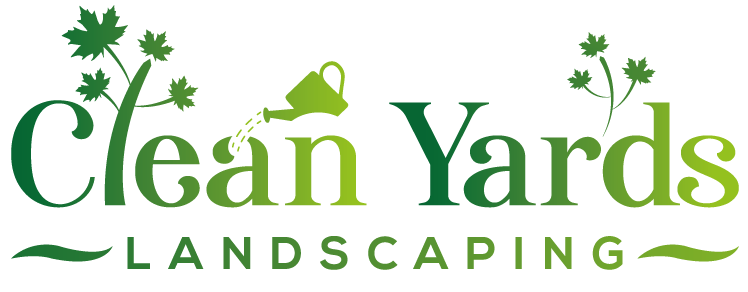Nepean Topiary Art: Shape Shrubs Like a Pro This Fall
Quick Guide: Master Nepean topiary this fall! Learn essential techniques, choose the right shrubs (Boxwood, Yew, Juniper), gather tools, shape simple forms, and provide winter care. Ideal for adding year-round structure to your Ottawa garden.
Ready to add sculpted elegance to your landscape? Request a free estimate today for professional topiary and landscaping services in Nepean.
Introduction: Bringing Sculptural Charm to Nepean Gardens This Fall
Picture this: the brilliant fall colours are sweeping across Nepean, maybe even catching the crisp morning air over in Barrhaven. As the main gardening rush slows down, perhaps you're gazing at your yard thinking your shrubs and hedges could use a little extra *something*, a touch of elegance before winter settles in. That's where the fun of topiary comes in! Essentially, topiary is the delightful art of sculpting living plants – carefully pruning shrubs and small trees into defined shapes like neat balls, tidy cones, or even spirals. Think of it as giving your garden a bit of sophisticated structure.
While spring pruning gets lots of buzz, fall is actually a *perfect* time for giving many evergreens their structural shape here in the Ottawa area. Tidying them up now helps define their form against the winter snow and gives your landscape lasting interest even when other plants are dormant. It’s a fantastic way to add personality to your landscaping.
Consider this your friendly guide to bringing that sculptural charm to *your* Nepean garden this autumn. We're not talking about overly complicated designs (unless you want to!), but rather the basics to get you started. We'll explore which plants are good candidates for fall shaping, simple techniques anyone can try, and practical tips for adding year-round structure and style to your outdoor space. Let’s get shaping!
What Exactly is Topiary? And Why Fall is Ottawa's Shaping Sweet Spot
Okay, let's dive deeper into this whole topiary thing. What exactly *is* it? Think of topiary as giving your plants a stylish haircut – but way more intentional than just a trim! It's the art and practice of training and clipping living shrubs or trees into specific, defined shapes. We're talking neat geometric forms like spheres (balls), cones, pyramids, or even playful spirals. It's a step beyond simple *hedge* trimming, adding real structure and personality to your landscaping. You might see examples dotting gardens from Manotick to Nepean, adding that touch of formal flair or whimsical charm.
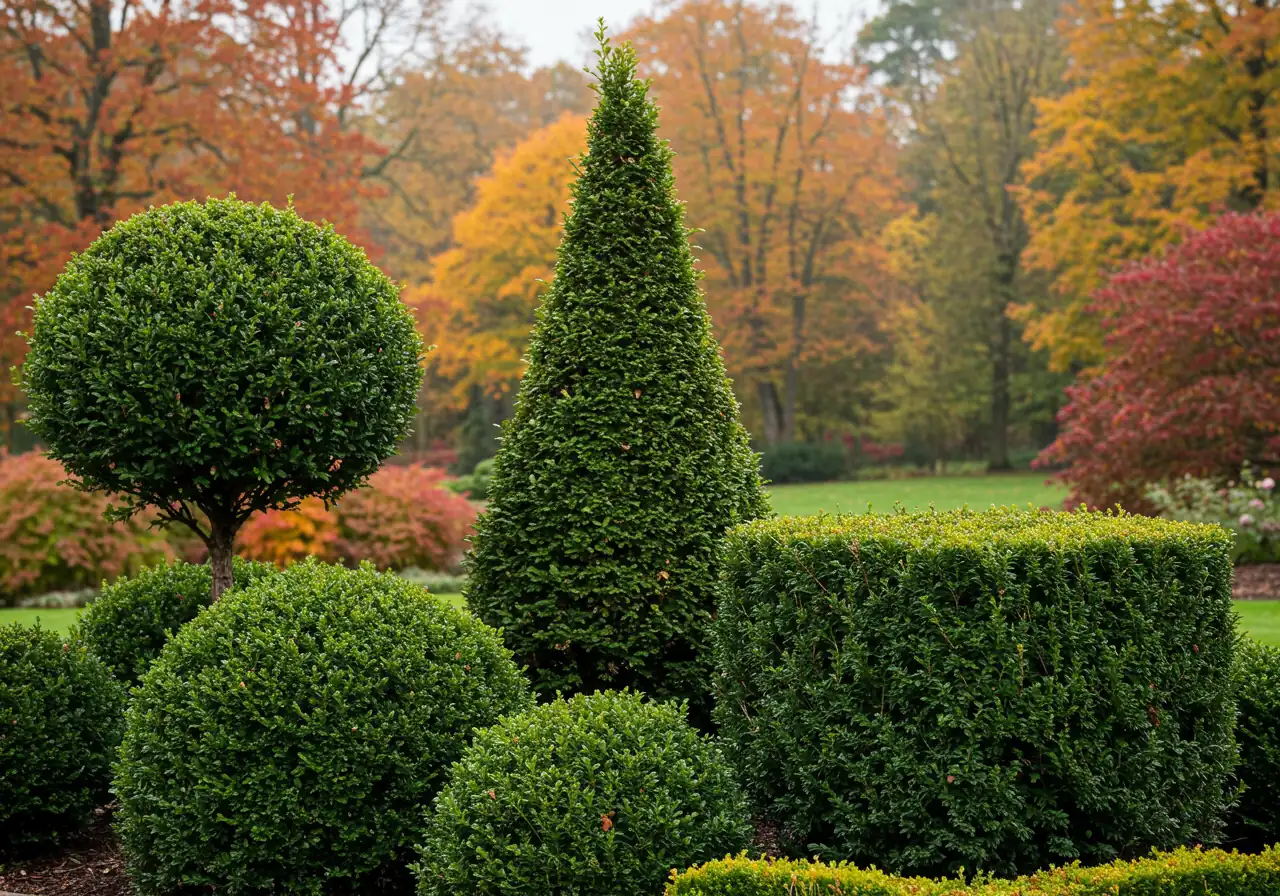
So, why is *fall* the shaping sweet spot here in Ottawa? It really boils down to plant biology and our lovely Zone 5a/5b climate. Timing is everything in gardening!
- Dormancy is Key: As temperatures cool down in autumn, most hardy *shrubs* (especially *evergreens* popular for topiary like yews, boxwoods, and some junipers) start slowing down their active growth. They're preparing for winter hibernation, shifting energy away from producing new, vulnerable leaves and towards strengthening their roots. *Pruning* them now is much less stressful than hacking away when they're actively pushing out growth in spring or summer. Think of it like having surgery when you're resting peacefully versus right after running a marathon!
- Less "Bleeding," Less Risk: Sap flow reduces significantly in the fall. This means cuts made during pruning heal cleaner and quicker, with less sticky sap oozing out (which can attract pests). This reduced sap flow also lowers the risk of diseases entering through the fresh wounds before the plant goes fully dormant for winter.
- Better Visibility for Precision: Especially once neighbouring deciduous trees start dropping their leaves, you get a much clearer view of your evergreen's underlying structure. It’s simply easier to see the "bones" of the plant and make those precise, careful cuts needed to achieve or maintain that perfect cone or sphere.
- Avoiding Spring Growth Spurts & Damage: While spring is crucial for tasks like kickstarting your lawn with Nepean Spring Lawn Aeration Ottawa or applying the right amendments like those in our Nepean Spring Mulch Tips for Clay Soil guide, major *shaping* of woody plants in spring can be tricky here. Pruning too early might remove flower buds on spring bloomers, while pruning later can stimulate a flush of tender new growth that's easily zapped by one of Ottawa’s notorious late frosts or sudden cold snaps. Fall shaping neatly sidesteps this gamble.
Think of fall topiary shaping as a rewarding part of your overall Nepean Fall Garden Prep for Colour and Winter. It fits right in alongside other essential autumn tasks like tidying beds and making sure your Nepean Irrigation Winterization is done to Avoid Pipe Damage. Getting those shapes defined now means you get to enjoy that elegant structure against the snow all winter long. Not sure where to start or feeling a bit shears-shy? Don't worry, getting professional help is always an option – you can explore our expert Landscaping Services for assistance!
Picking Your Partner: Best Shrubs for Topiary Success in Nepean & Beyond
Okay, let's talk about choosing your leafy dance partner! Picking the right shrub for topiary is half the battle – you want something that’s willing to be shaped and can handle our sometimes dramatic Ottawa weather. Not every shrub dreams of becoming a perfect sphere, you know! Getting this choice right sets you up for *landscaping* success, whether you're in Nepean, Barrhaven, or out enjoying the spacious lots in Greely.
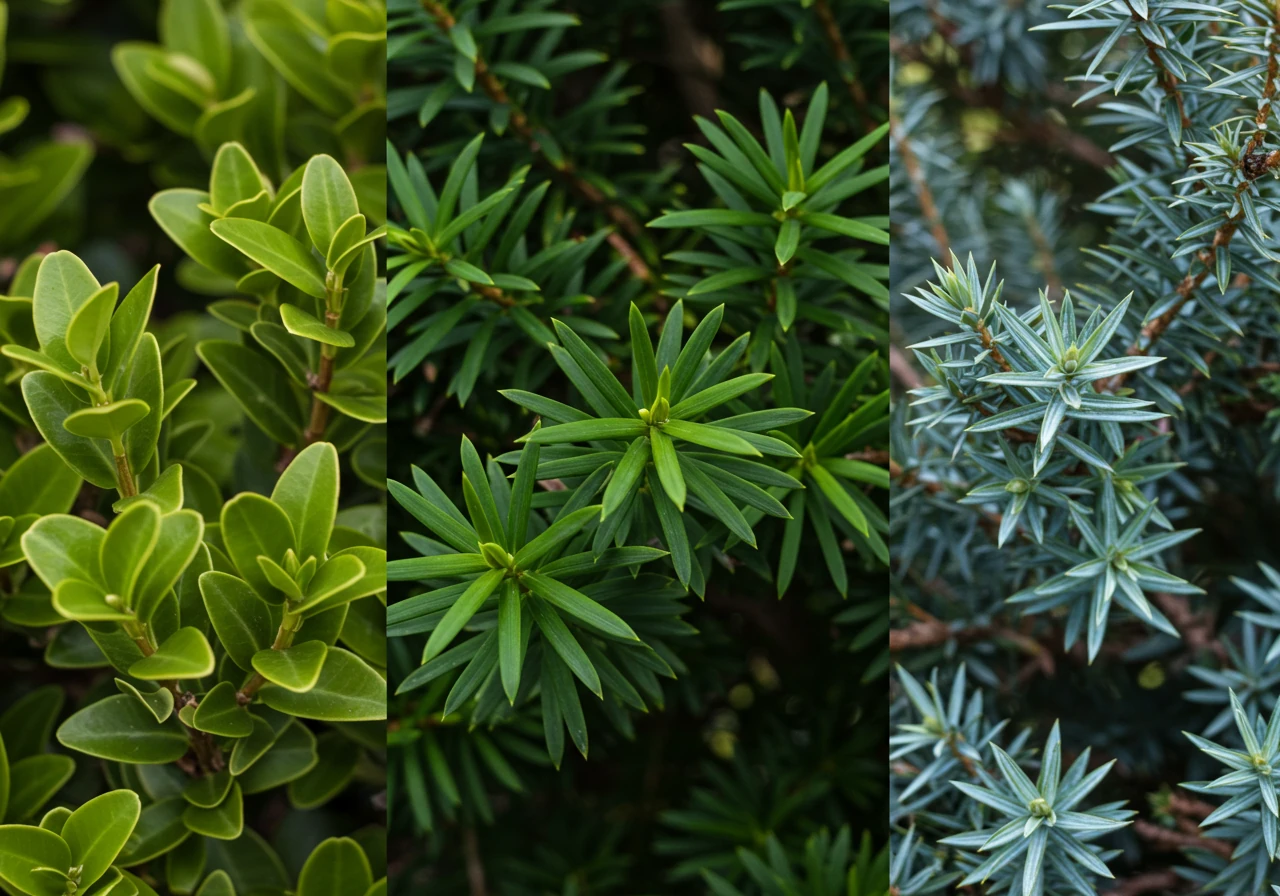
First off, consider our local conditions. We're generally in hardiness Zone 5a or 5b, meaning plants need to withstand chilly winters. Soil can vary wildly too, from heavy clay to sandier spots (learn about dealing with clay in our spring mulch tips). It’s always smart to check the plant tag for zone hardiness and ask the experts at local nurseries – they know what thrives best from Manotick to Metcalfe. A little prep work now saves heartache (and plant-ache!) later. For guidance on plant selection suited to your property, consider checking resources like the Master Gardeners of Ottawa-Carleton. If your garden beds aren't quite ready for a new addition, consider getting things ship-shape with a thorough Nepean Garden Clean Up Service before you plant.
For classic topiary, *evergreens* are usually the stars of the show because they keep their shape and colour year-round. Here are the top contenders for our area:
- Boxwood (Buxus): The quintessential topiary plant!
- Pros: Tiny leaves, dense growth habit, creates crisp, formal shapes. Tolerates shade. Several hardy varieties exist for Ottawa.
- Cons: Can be prone to winter burn (browning) if exposed to harsh winter winds and sun – careful placement or winter protection might be needed. Relatively slow growing (patience is a virtue!). Can be susceptible to boxwood blight, though resistant varieties are increasingly available.
- Yew (Taxus): A super reliable and forgiving choice.
- Pros: Very hardy, shade tolerant (even deep shade!), takes shearing well (you can prune it back hard if needed), nice dark green colour.
- Cons: All parts (except the fleshy red berry part) are toxic if ingested – important if you have curious pets or kids. Can eventually get quite large if you don't stay on top of pruning. Slower growth than some options.
- Juniper (Juniperus): Offers variety in texture and form.
- Pros: Many cultivars with different colours (blue-greens, yellows) and textures. Generally tough, drought-tolerant once established. Full sun lovers.
- Cons: Some varieties are prickly to work with (wear gloves!). Can grow quickly, requiring more frequent trimming to maintain shape. Doesn't always respond well to very hard pruning into old wood.
- Dwarf Alberta Spruce (Picea glauca 'Conica'): Often sold pre-shaped.
- Pros: Naturally grows in a dense, conical shape, very slow-growing (less pruning needed!). Hardy.
- Cons: Very prone to spider mites, which can cause browning and needle drop (inspect regularly!). Doesn't tolerate being cut back into old, thick wood. Prefers full sun.
Shrub Comparison
| Shrub Type | Pros | Cons | Ideal Use |
|---|---|---|---|
| Boxwood | Dense, small leaves, shade tolerant | Slow growth, potential winter burn/blight | Formal shapes, low hedges |
| Yew | Hardy, shade tolerant, forgives hard pruning | Toxic parts, can get large, slow growth | Reliable shapes, hedges, shade |
| Juniper | Variety (color/texture), drought tolerant, full sun | Prickly, faster growth, dislikes hard pruning | Various shapes, sunnier spots |
| Dwarf Alberta Spruce | Natural cone, very slow growth, hardy | Prone to spider mites, dislikes hard pruning | Low-maintenance cones, accents |
While evergreens provide year-round structure, some *deciduous shrubs* like Privet (Ligustrum) can also be used for topiary, offering seasonal interest. However, they'll lose their leaves and definition in winter.
*Eco-Friendly Tip:* Whenever possible, lean towards native or well-adapted non-invasive species. They generally require less water, fertilizer, and fuss once established, making them a greener choice for your garden and reducing the need for extensive property clean up later if they fail to thrive. The City of Ottawa's tree planting resources can offer guidance on suitable species.
Choosing the right shrub is just the first step. Proper planting, watering, and ongoing care are key. If you're planning a larger *landscaping* project, maybe even adding new lawn areas with our Sod Installation Service, integrating your topiaries thoughtfully from the start makes a big difference. And remember, keeping the surrounding area tidy is important too – whether it's routine maintenance or a larger seasonal refresh like our Ottawa Yard Cleanup Service covers. Feeling overwhelmed? You can always call in the pros for help with selection, planting, or maintenance – check out our full range of Landscaping and Gardening Services!
Gearing Up: Your Topiary Toolkit and Basic Training
Okay, so you've picked your perfect evergreen dance partner, maybe a sturdy yew or a classic boxwood, and you're ready to start sculpting! Before you charge out there like Edward Scissorhands, let's talk about getting the right gear. Don't worry, you don't need a workshop full of complex gadgets, especially when starting out.
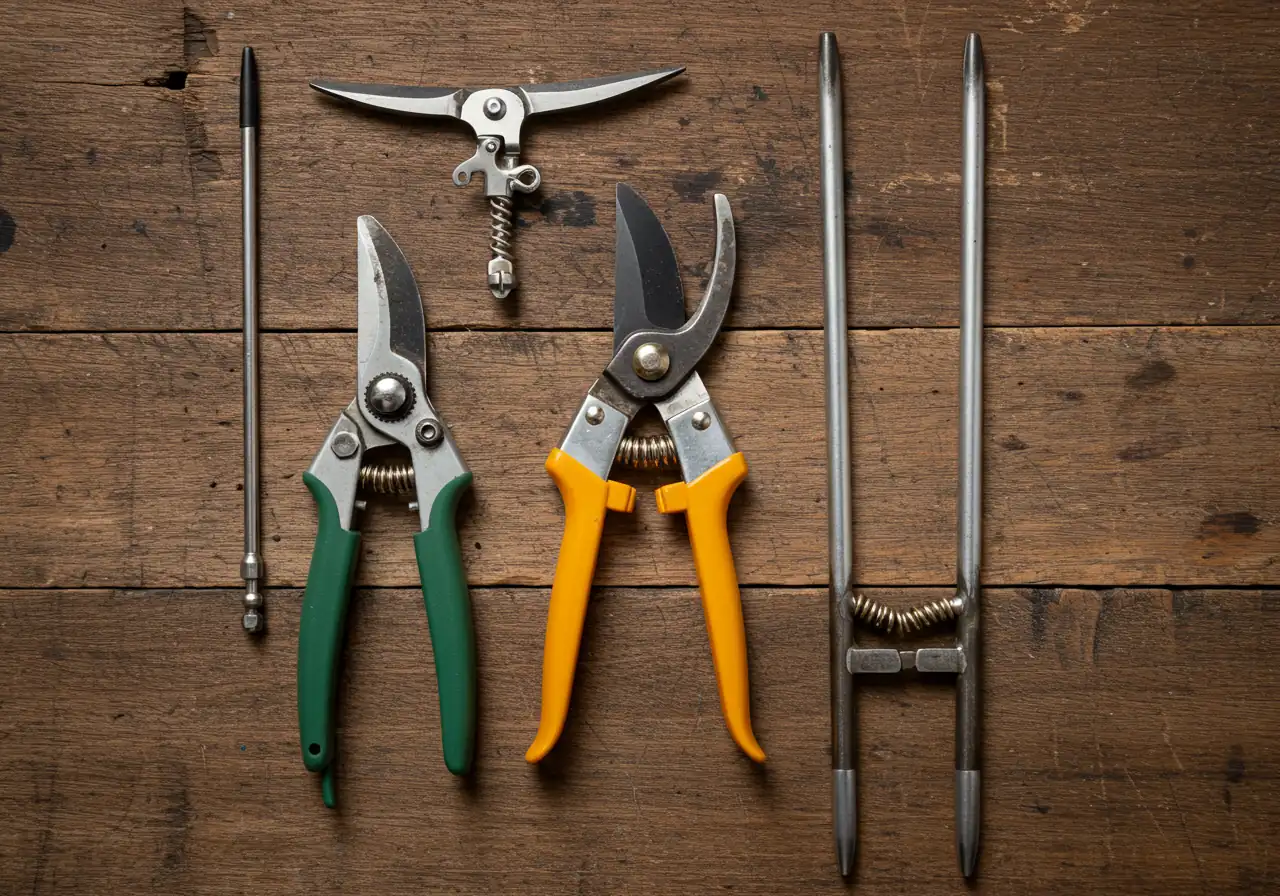
Your Topiary Toolkit: Hand vs. Power
Think of your tools like artist's brushes – different ones for different strokes.
- Hand Shears (Topiary Shears or Sheep Shears): These are your precision instruments. They usually have shorter blades and allow for very detailed, careful cuts – perfect for refining shapes and getting those smooth curves on smaller *shrubs*. They give you maximum control. One-handed pruning shears (secateurs) are also essential for snipping slightly thicker, individual stems cleanly.
- Hedge Shears: These are the longer-bladed cousins of hand shears. Great for tackling larger surfaces, defining straight lines on *hedges*, or doing the initial rough shaping on bigger *evergreens*. They cut a wider swath but offer less fine detail control.
- Loppers: For branches thicker than your thumb that shears can't handle. Use sparingly in topiary, mostly for removing misplaced larger limbs during the initial structuring.
- Power Hedge Trimmers (Electric or Battery): These can save a *lot* of time and elbow grease on large topiary pieces or long hedges, perhaps along a bigger property in areas like Metcalfe. *However*, they are far less precise. Use them for the initial "blocking out" of a shape, then switch to hand shears for the detail work. *Beginner Warning:* It's *very* easy to take off too much too quickly with power trimmers! Go slow.
Shaping Aids: Training Wheels for Shrubs
Feeling a bit intimidated by freehand shaping? Wire frames are your friends! You can buy pre-made frames in various shapes (balls, cones, spirals, even animals!) or make your own with sturdy wire. Place the frame over a young, flexible plant and prune anything that grows outside the frame. Eventually, the plant fills the shape. It’s a fantastic way to ensure symmetry, especially for geometric forms.
Tool TLC and Safety First!
Dull tools tear plant tissue, inviting disease, and make *your* job harder (and potentially more dangerous). Sharp tools make clean cuts that heal faster.
- Keep 'em Sharp: Learn to sharpen your blades regularly or have them professionally sharpened.
- Keep 'em Clean: Wipe blades clean after *each* use, especially if working on multiple plants, to prevent spreading potential diseases. A quick wipe with rubbing alcohol or a disinfectant spray is wise. Sap can gum things up quickly! Keeping the surrounding area tidy helps too; you don't want tools lost in debris. A good seasonal cleanup, like a Comprehensive Ottawa Property Cleanup Service, makes finding things easier.
- Safety Gear: Always wear sturdy gardening gloves to protect against blisters and prickles. Eye protection is *non-negotiable* – flying twigs or debris are no joke!
Basic Training: Shaping a Simple Ball
Ready for your first masterpiece? Let's try a basic ball shape on a small evergreen like a boxwood.
- Visualize: Stand back and look at your shrub. Imagine the perfect sphere within it. Squinting helps! (Seriously, it does).
- Rough Cut (Optional): If it’s quite overgrown, use hedge shears or *cautiously* use power trimmers to knock off the major growth outside your imaginary ball. Think rough sphere, not finished product.
- Top Down: Start at the top-center of your imaginary sphere. Using hand shears, make small, clipping cuts, working downwards and outwards, rotating around the plant. Don't try to cut deep; skim the surface.
- Step Back Often: Every few minutes, put the shears down, step back several feet, and look at the overall shape from different angles. Is it balanced? Where are the high spots? This is the *most* important step! It’s easy to get lost in the details up close.
- Refine: Continue making small, overlapping cuts, smoothing the curve. Aim to cut just the leafy tips, not thick wood. Think of it like trimming hair, just a little off the ends.
- Clean Up: Rake up all the clippings from the *garden beds* and surrounding area. Leaving them can smother grass or harbour pests. Proper property clean up is part of the process, whether you do it yourself or look into options like a Metcalf Yard Cleanup Service for larger jobs. A tidy space around your new creation makes it look even better – think about the pristine look offered by a Metcalf Garden Clean Up Service for the immediate plant vicinity, or even the thoroughness of a Marionville Garden Clean Up Service for ongoing neatness.
Remember, gardening is a journey! Your first attempt might be more of an "eggplant" than a perfect sphere, and that's okay! Plants grow back. Practice makes perfect. Soon, your shaped shrubs could be key features in your *landscaping*, maybe even inspiring a whole new look or additions via a professional Garden Install service. Happy snipping!
Shape Up! From Simple Spheres to Showstoppers in Your Ottawa Garden
Alright, you've got your trusty shears and maybe a slightly nervous evergreen shrub staring back at you. Let's talk shapes! While you *could* go full-on whimsical peacock (go you!), most folks start with the classics. Moving beyond basic *hedge* trimming into actual shapes is where the real *gardening* fun begins, adding focal points that can elevate your entire *landscaping* design, whether you're in Richmond or over in Kars. Consider visiting local public gardens or looking through resources from the Ottawa Horticultural Society for inspiration.
The Geometric Gang: Spheres, Cones, and Cubes
- The Sphere (Ball): We touched on this one – it's the friendly introduction to topiary. The key is constant rotation and small, skimming cuts. Think of peeling an orange, trying to keep it perfectly round. It's surprisingly forgiving, and a few well-placed spheres can bring a lovely, soft structure to your *garden beds*.
- The Cone/Pyramid: A bit more formal, often used for entranceways. Imagine a triangle shape from the side. Start wider at the base and taper your cuts evenly towards a single point at the top. Use stakes and string as guides if you like straight lines! Don't rush – a wonky cone takes time to fix.
- The Cube: Sharp, modern, and definitely makes a statement. This one benefits *hugely* from guides. Stakes at the corners and string stretched taut between them give you clear lines to follow. Use your longer hedge shears for the flat sides and top, then refine corners with hand shears.
Beyond the Basics: Spirals and Tiers
Feeling brave? Spirals look complex but often start with a cone shape. Wrap twine or flexible tape around the plant in the desired spiral pattern. Then, using hand shears, carefully cut shallow channels along the guide lines. Gradually deepen these channels over successive *pruning* sessions. Tiers (like a wedding cake) involve selecting horizontal branches at intervals and encouraging flat growth, while keeping the trunk clear between them. These advanced shapes truly demand patience!
Patience is Your Pruning Superpower
Seriously, topiary isn't an overnight transformation. It's a gentle conversation with your plant over seasons, maybe even years. Think *gradual refinement*. Trying to achieve the perfect shape in one go often stresses the *shrub* and leads to mistakes. Light, frequent trims (once or twice a growing season, plus that fall tidy-up) are far better than one massive hack-job. Remember, you can always take more off, but you can't stick it back on! If you prune too much, step back, take a breath, and let the plant recover. Sometimes fixing a mistake just means waiting for new growth.
Eco-Friendly Snipping
Healthy plants make the best topiaries. Use those sharp, clean tools we talked about to prevent disease. What about the clippings? Don't just bag 'em for the curb! Small evergreen clippings can be added (in moderation) to your compost pile, returning nutrients to your soil (check out our tips on soil preparation for healthy gardens). Avoid composting diseased material, though. Keeping the area around your shaped *shrubs* tidy also prevents pests and diseases. While a professional Ottawa Garden Clean Up Service is great for seasonal overhauls, make it a habit to rake up clippings after each trim. For larger amounts of garden waste, composting is ideal, reducing landfill load – though if you have a massive amount after a big shaping session, a full Ottawa Property Cleanup Service might be necessary. Ensuring clippings don't smother your lawn or surrounding plants is key – something tackled by services like a thorough Marionville Yard Cleanup Service. Even keeping the immediate base clear, like the detailed work from a Marionville Garden Clean Up Service, helps air circulation. Designing gardens that attract beneficial insects can also help manage pests naturally; the Canadian Wildlife Federation has great resources on gardening for wildlife.
Oops! Common Shaping Hiccups
- Lopsided: Almost always happens because you didn't step back enough! Walk around, view from afar, then adjust slowly.
- Bare Patches: Can happen from cutting too deep into old wood (especially on spruce or juniper) or from winter damage. Sometimes, you just need patience for regrowth. Other times, you might need to slightly adjust the overall shape to disguise it.
Topiary adds year-round structure and personality. That perfectly rounded sphere or sharp cone looks fantastic against an Ottawa winter snowdrift. If you find yourself struggling or want more complex shapes without the learning curve, professional help is always an option. Don't hesitate to Contact Us to discuss how we can bring sculpted style to your garden. You can also find us on Google!
Topiary Shaping Timeline: A Seasonal Overview
Summer (June - August)
Perform light trimming to maintain shape as needed, especially on faster-growing shrubs like Juniper. Avoid heavy pruning during heat waves. Ensure adequate watering. This is a good time for general garden maintenance.
Fall (Late September - October/Early November)
Prime Time for Structural Shaping! Prune established evergreens (Yew, Boxwood, Juniper) into desired forms before deep frost. Clean cuts heal well as plants enter dormancy. Part of your fall garden prep.
Late Fall / Early Winter (November)
Apply protective mulch. Deep water before ground freeze. Consider anti-desiccant sprays or burlap wrapping for sensitive plants. Essential winter prep like irrigation winterization should be completed.
Choosing Your Canvas: Top Shrub Options Compared
Boxwood (Buxus)
The classic choice for formal topiary. Small leaves allow for crisp lines and intricate shapes. Prefers well-drained soil and some protection from harsh winter wind/sun. Slow growing. Great for spheres, cubes, and low hedges. Ensure good air circulation to minimize disease risk. Needs consistent mulching and edging for optimal health.
Yew (Taxus)
Highly adaptable and forgiving. Tolerates shade and heavy pruning better than most evergreens. Dark green needles provide a great backdrop. Very hardy for Ottawa winters. Can be shaped into cones, pyramids, and hedges. Note: All parts except the red berry flesh are toxic. Ideal for foundational garden installations.
Juniper (Juniperus)
Offers diverse textures and colours (green, blue, gold). Thrives in full sun and well-drained soil; drought tolerant once established. Good for spirals, cones, and spreading forms. Some varieties can be prickly. Responds best to light, regular trimming; avoid cutting into old wood. Requires good soil preparation for drainage.
Dwarf Alberta Spruce (Picea glauca 'Conica')
Naturally grows into a dense cone shape, requiring minimal shaping. Very slow growing. Prefers full sun and consistent moisture. Prone to spider mites, requiring vigilance. Not suitable for hard pruning. Excellent as a low-maintenance accent plant. Proper material selection is key if pairing with other plants.
Growth Rate Comparison (Approximate)
Understanding growth rates helps plan maintenance frequency.
Note: Chart represents relative growth rates; actual growth depends on specific cultivar and conditions.
Tucking Them In: Fall & Winter Care for Your Nepean Topiary Sculptures
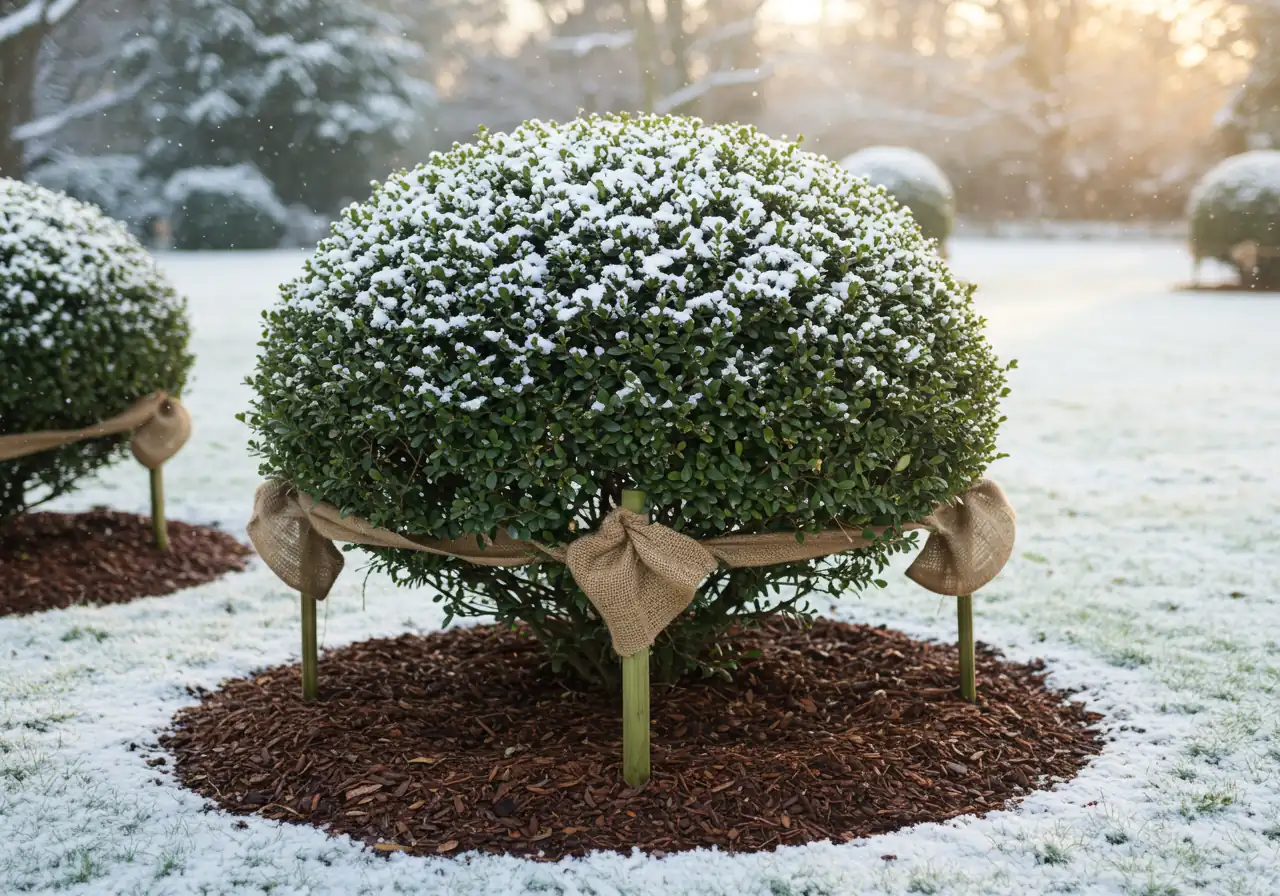
Alright, you’ve done the shaping, stood back, admired your work (maybe even gave your shrub a little high-five?), and now it's time to tuck your newly sculpted *evergreens* in for their long winter nap. Just like we pull on a cozy sweater, our topiaries appreciate a bit of protection from Ottawa’s frosty embrace, especially after a fresh *pruning*. Proper winter care ensures your shapely *shrubs* survive and thrive, ready to wow again next spring.
Think of fall post-pruning care as putting on your plant’s winter PJs. Here’s how to keep them snug in Nepean:
- Mulch is Magic: Before the ground freezes solid, apply a generous layer (2-3 inches) of organic mulch, like shredded bark or wood chips, around the base of your topiary. Extend it out to the drip line (the edge of the branches). Mulch acts like a cozy blanket for the roots, insulating them from the harsh freeze-thaw cycles common here, which can heave plants right out of the ground! It also helps retain moisture in the soil. Just be sure not to pile mulch directly against the trunk, as this can invite pests and rot. Keep the immediate area tidy before mulching; ensure all fallen leaves and debris are removed from the *garden beds* – something a thorough Marionville yard cleanup service tackles expertly. Learn more about proper techniques with our Mulching and Edging guide.
- Hydration Station & Winter Coats: Give your topiaries one last deep watering in late fall, before the ground freezes hard. *Evergreens* continue to lose moisture through their needles/leaves even in winter (a process called transpiration). When the ground is frozen, they can't replenish that water, leading to dehydration and dreaded winter burn (browning). For extra protection, especially for broadleaf evergreens like Boxwood or those in exposed, windy locations (think areas like Osgoode or Metcalfe), consider applying an anti-desiccant spray in late fall when temperatures are still above freezing. These sprays create a waxy coating that helps reduce moisture loss.
- Burlap Bundles: For young plants, sensitive species (hello again, Boxwood!), or topiaries in very exposed spots, wrapping them in burlap can be a lifesaver. This shields them from harsh winter winds and sun scald (yes, winter sun can burn!). Drive a few stakes into the ground around the plant and wrap the burlap around the stakes, leaving a gap between the fabric and the plant for air circulation. Avoid wrapping tightly directly against the foliage, which can trap moisture and cause issues. You can secure the burlap with twine. Clearing the area properly makes this job easier; for larger properties needing significant preparation before winter, utilizing a Metcalf property cleanup service ensures you have clear access.
- Snow Patrol: While snow provides insulation, heavy, wet Ottawa snow can accumulate on your carefully shaped topiaries and break branches. Gently brush off heavy snow loads with a broom (sweeping upwards) or your hands whenever possible. For very delicate shapes, you could even build a simple A-frame structure over the topiary to deflect the worst of the snow.
Quick Fall/Winter Topiary To-Do:
- *Late October/Early November:* Final light tidy-up *pruning* if needed, deep watering, apply mulch.
- *Mid-November (Before Deep Freeze):* Apply anti-desiccant spray (optional), wrap sensitive plants with burlap.
- *Throughout Winter:* Gently remove heavy snow accumulation as needed.
Taking these steps helps guarantee your topiaries survive the winter looking their best, contributing beautifully to future landscaping transformations. If managing winter protection for multiple topiaries or complex shapes seems daunting, professional help is available. When considering assistance, you can easily book an estimate to discuss your needs, and rest assured we handle your personal information carefully as detailed in our Privacy Policy. Sweet dreams, little shrubs! For details on service agreements, please see our Terms and Conditions.
HIGHLIGHT BOX: Nepean Topiary Pro-Tips
- Choose Wisely: Start with tough *evergreens* that laugh at Ottawa winters, like Yews or hardy Boxwoods. Not sure what thrives in your Barrhaven backyard? Existing clients can review past plant recommendations or service history via our Secure Customer Portal.
- Step Back, Snip Smart: Avoid lopsided blobs by frequently stepping back to view your *shrub* from all angles during *pruning*. Keep the area tidy by raking clippings; for larger clear-outs after major shaping, a dedicated service like the Marionville Property Cleanup Service can handle the debris.
- Sharp Tools Rule: Clean cuts heal faster and look better! Keep your shears sharp and clean – it makes *gardening* easier and is just as crucial for precision work as it is for crisp results in Mulching and Edging.
- Winter Blanket Bonus: Before the deep freeze hits Nepean, tuck your topiary roots in with a cozy layer of mulch. Applying proper Mulching and Edging is key to protecting roots from harsh freeze-thaw cycles and retaining moisture.
- Patience is Key (Seriously!): Perfect shapes take time and gentle trimming over seasons. Don't rush it! If you'd rather leave it to the experts, we're happy to help shape your *landscaping* vision (and rest assured, we always handle your project details responsibly, as outlined in our Privacy Policy). Ready to proceed after an estimate? You might be directed to our Thank You page upon completion.
FAQs: Your Nepean Topiary Questions Answered
Maybe! It really depends on the health and type of your existing *shrub* and how dense its growth is. Older, woodier plants, or those with naturally open habits, can be trickier to shape into tight forms than young, vigorous *evergreens* like yew or boxwood. You might be able to impose *some* shape with careful *pruning* over time, but don't expect miracles overnight. Starting with a suitable young plant often gives better, faster results. Not sure what's possible? Taking a peek at different finished projects can help – check out examples of various shaped shrubs in our online project gallery.
That's a valid Ottawa concern! Most hardy *evergreens* suitable for topiary (like yews and junipers) are pretty tough and can handle typical snow loads. The main risk comes from *heavy*, wet snow clinging to branches and potentially causing breakage on more delicate shapes. Gently brushing accumulated snow off (use an upward motion with a broom) after a big storm helps. Proper fall preparation, like ensuring the plant is well-hydrated before the ground freezes and maybe using burlap wrap for sensitive or exposed plants, gives them their best chance to stand tall till spring.
Let's be real, it *is* a bit more of a commitment! While basic *hedge* trimming might happen once or twice a year, maintaining a defined topiary shape usually requires more frequent, lighter *pruning* – maybe 2-3 times during the growing season, plus a fall tidy-up. It's detailed work needing sharp hand shears for precision. Think of it like the difference between just mowing your lawn versus investing in detailed Ottawa lawn care and maintenance for that perfect look. You also need to keep up with watering, potential feeding, and pest checks to keep the plant healthy enough to look good. Whether it's "worth it" depends on how much you value that sculptural look! Seeing the polished results others have shared through our customer estimate and feedback system can show you the impact well-maintained topiaries have on *landscaping*.
Spirals and other complex shapes look fantastic but are definitely more advanced! They require patience, a good eye, and careful, gradual *pruning* over several seasons, often using guides. For a beginner, we absolutely recommend starting with simpler geometric shapes like a sphere (ball) or a cone. Master the basics of shaping, learn how your chosen *shrub* responds to *pruning*, and build your confidence first. You can always tackle a spiral later! If you're curious about our approach to *gardening* and tackling trickier *landscaping* challenges like detailed shaping, you can learn more about our company's experience and philosophy. Sometimes, knowing you have expert backup available makes trying something new less daunting!
Conclusion: Shape Your Nepean Landscape with Artistic Flair
So there you have it – your crash course in adding a little sculpted sophistication to your Nepean garden! Topiary is a fantastic way to inject personality into your landscaping, turning ordinary *shrubs* and *evergreens* into living art. And remember, fall here in the Ottawa area is prime time for this kind of structural *pruning*, setting your garden up for visual interest right through the winter months.
Feeling inspired to grab those shears and give it a go? We say, absolutely! Start simple with a basic sphere, be patient (your *shrubs* will thank you for not giving them a hack job!), and don't be afraid to experiment. Even a slightly quirky sphere adds more character than a plain old blob. But hey, we get it – maybe you envision perfectly crisp cones flanking your walkway, or you simply don't have the time (or the Zen master patience) for detailed *gardening* like this. If shaping *hedges* and *shrubs* feels more like a chore than a charming challenge, or you want that guaranteed professional polish from the start, we're here to lend a hand (and our very sharp shears).
Ready to transform your yard with expert shaping? Contact Clean Yards today for a consultation! We bring artistic flair and precision *pruning* to landscapes across *Nepean*, *Manotick*, *Greely*, *Barrhaven*, and the wider Ottawa region. Let's discuss how we can bring your topiary vision to life. Don't just dream about a stunning landscape – let's sculpt one together!
Get Your Free Topiary EstimateNeed help with other aspects of yard care? Explore our full range of services, including soil preparation and material selection.
